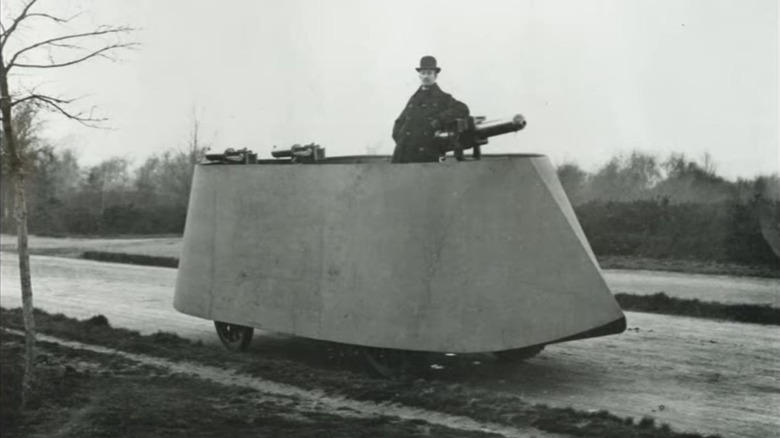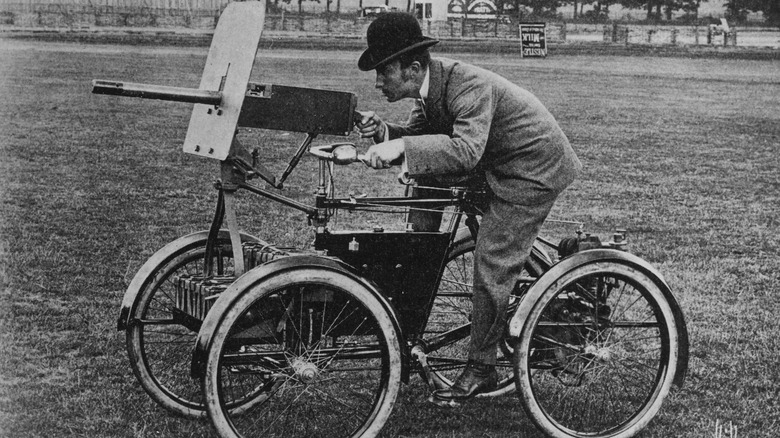The First Armored Car Ever Built Isn't What You'd Think
The tank, that thickly armored combat vehicle bristling with guns that moves across the ground on metal treads, didn't always look like a "tank." While you may know that Arnold Schwarzenegger owns one, you may not realize how far armored vehicles go back in history.
The first recorded use of a "vehicle" in warfare starts with the Egyptians and Hittites (circa 2nd millennium BCE), who used horse-drawn chariots to mobilize archers. "Protected vehicles" started appearing during the Middle Ages (circa 9th century BCE) when the Assyrians used wheeled siege towers and battering rams. Fast forward some five hundred years (to 1335) when the design for a "battle car" was drawn up by Guido da Vigevano. And, of course, we have Leonardo da Vinci's famous sketch of an "armored car" from 1485 (via Britannica).
Jump ahead another 400 years to 1885, when one James Cowen of England took out the very first patent for a wheeled, armored vehicle with mounted guns (via Britannica). This is about where a chap named Frederick Richard Simms comes into the picture.
Simms was born in 1863 in Hamburg, Germany, but lived and went to school in Berlin until his mid-twenties. He was an entrepreneurial juggernaut — part businessman, engineer, and inventor — who would later become known as "The Father of the British Motor Industry."
Get on your bike and ... fire your machine gun
Simms met German engineer Gottlieb Daimler sometime in 1889 (via Jaguar Daimler Heritage Trust) and procured a license to build high-speed engines. He promptly moved to London, England, became a mechanical engineer (via The Online Tank Museum), and engaged in all manner of automotive designs and creations. He came up with the words "petrol" and "motorcar" and, along with German engineer Robert Bosch, invented the Simms-Bosch ignition magneto (via Jaguar Daimler Heritage Trust).
In January 1898, Simms applied for a patent that would protect "turrets, armored cars, shields and the like" through "pneumatic spaces" filled with Indian rubber that would effectively absorb kinetic energy created by a projectile's impact. Three months later, he patented a "Motor Driven Car for Use in Warfare" (via The Online Tank Museum).
In 1899 he created his first armed military vehicle, the Motor Scout Quadricycle, a four-wheeled motorbike with a .303 caliber Mark IV Maxim automatic machine gun capable of firing 1,000 rounds attached to the front. It had a bulletproof shield in front for the driver to hide behind (via The Online Tank Museum). It was never made in masse or used by the military, but that didn't stop Simms from trying.
Using the Motor Scout as a starting point, Simms began working on his next project, one that would take him, along with builders Vickers, Sons & Maxim, almost three years to complete (via The Online Tank Museum).
The car built for war
The British Army ordered Simms' Motor War Car in April 1899 and planned to use it against the two Boer republics (South African Republic and the Orange Free State) during the Second Boer War (via The Vintage News).
Simms' design used a unique Daimler truck chassis his own company built (via The Online Tank Museum) and strapped on a four-cylinder 3.3-liter 16hp Cannstatt-Daimler engine with a top speed of 9 miles per hour. Vickers provided the 6mm thick armor, while Maxim added two .303 caliber Mark IV Maxim automatic machine guns, each capable of a 360°firing spread. A Quick Fire 1 Pounder autocannon (aka pom-pom gun) was also installed (via Jaguar Daimler Heritage Trust).
The Motor War Car was 28 feet long and ran on four spoked wheels made from wood (like wagon wheels) wrapped with steel straps (via The Online Tank Museum). The cigar-shaped armored ends could be used like battering rams, and the edges of the sloped sides were honed to a razor-sharpness. If that wasn't enough stopping power, it had an onboard dynamo that electrified the outer skin, making it even harder for the enemy to climb aboard (via The Online Tank Museum).
When the War Car was finally unveiled at London's Crystal Palace Motor Show in February 1902, the Second Boer War was winding down (via Britannica), and it was no longer needed. In fact, the British Army didn't even attend the show. Even though only one prototype was built and never used, it still goes down as the first armored car ever built.

